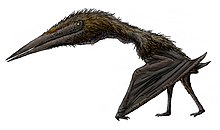Aerotitan
| Aerotitan Temporal range: Maastrichtian
~ | |
|---|---|

| |
| Life restoration of Aerotitan | |
| Scientific classification | |
| Domain: | Eukaryota |
| Kingdom: | Animalia |
| Phylum: | Chordata |
| Order: | †Pterosauria |
| Suborder: | †Pterodactyloidea |
| Family: | †Azhdarchidae |
| Genus: | †Aerotitan Novas et al. 2012 |
| Species: | †A. sudamericanus
|
| Binomial name | |
| †Aerotitan sudamericanus Novas et al. 2012
| |
Aerotitan is a genus of azhdarchid pterosaur that lived during the Maastrichtian age of the Late Cretaceous period in what is now Argentina. Its only remains, which consist of a partial snout, were found in the Allen Formation of the Neuquén Basin in northern Patagonia. This specimen was made the holotype of Aerotitan sudamericanus by paleontologist Fernando Novas and colleagues. The generic name combines the Greek word ἀήρ, meaning "air" and Titan, alluding to the pterosaur's large size. The specific name is a reference to its origin, South America.
Aerotitan is the first pterosaur belonging the family Azhdarchidae that was found in South America. A wingspan of at least 5 m (16 ft) has been estimated for this pterosaur. Within Azhdarchidae, the genus Mistralazhdarcho from France seems to have been the closest relative of Aerotitan, based on numerous phylogenetic analyses that have recovered them together in a clade.
Discovery and naming
[edit]The holotype and only specimen of Aerotitan, MPCN-PV 0054, has been recovered near the Bajo de Arriagada site in Patagonia, Argentina, from a layer of the upper Allen Formation. It consists of a partial rostrum (snout). The type species is Aerotitan sudamericanus, which was named and described in 2012 by paleontologists Fernando Novas, Martin Kundrat, Federico Agnolín, Martin Ezcurra, Per Erik Ahlberg, Marcelo Isasi, Alberto Arriagada and Pablo Chafrat. The generic name Aerotitan is derived from the Greek word ἀήρ, aer, meaning "air", and Titan, in reference to the fact that the species represents a large flying reptile. The specific name sudamericanus refers to its provenance from South America.[1]
Description
[edit]The only specimen of Aerotitan that has been described is an incomplete snout, which has a preserved length of 264 mm (10.4 in). It is elongated and transversely compressed, the jaws being toothless. Based on this specimen, the wingspan of Aerotitan has been estimated to be at least 5 m (16 ft).[1] In 2021, a thorough analysis by paleontologist Rodrigo Pêgas and colleagues concluded that this specimen represented the lower jaw, contrasting with a few previous studies that have concluded it as an upper jaw. Comparing it with specimens of other azhdarchids, they deduced that the genus Mistralazhdarcho from France shared the most features, especially the mandibular tip.[2]
Classification
[edit]In its description, Aerotitan was assigned to the family Azhdarchidae. This would make it the first unambiguous azhdarchid found in South America.[1] However, in 2018, a study published by paleontologist Nicholas Longrich and colleagues classified Aerotitan as a member of the family Thalassodromidae, being the sister taxon of Alanqa (a pterosaur also assigned as an azhdarchid in its initial description). Such assignment is stated as only tentative and is not well-supported.[3] As is the case, in their 2021 analysis, Pêgas and colleagues noted dissimilarities between Aerotitan and pterosaurs belonging to the Thalassodromidae (referred to as Thalassodrominae in the analysis, based on its placement within Tapejaridae at the time). They supported an azhdarchid identity for Aerotitan, reverting back to its original classification during its initial description.[2] In the same year, a phylogenetic analysis by American paleontologist Brian Andres placed Aerotitan within Azhdarchidae, further corroborating its initial placement. Within Azhdarchidae, it is recovered in the subfamily Azhdarchinae, as the sister taxon of Mistralazhdarcho.[4] Its close relationship with said taxon would later be demostrated again in a 2023 study by Pêgas and colleagues. However, instead of finding Aerotitan within Azhdarchinae, they recovered it within the subfamily Quetzalcoatlinae, forming a trichotomy with both Mistralazhdarcho and Arambourgiania.[5]

|
Cladogram by Andres (2021).
|
Cladogram by Pêgas and colleagues (2023).
|
See also
[edit]References
[edit]- ^ a b c Novas, F. E.; Kundrát, M.; Agnolín, F. L.; Ezcurra, M. D.; Ahlberg, P. E.; Iasi, M. P.; Arriagada, A.; Chafrat, P. (2012). "A New Large Pterosaur from the Late Cretaceous of Patagonia". Journal of Vertebrate Paleontology. 32 (6): 1447–1452. Bibcode:2012JVPal..32.1447N. doi:10.1080/02724634.2012.703979. hdl:11336/98097. JSTOR 23361061. S2CID 84340520.
- ^ a b Pêgas, R.V.; Holgado, B.; Ortiz David, L.D.; Baiano, M.A.; Costa, F.R. (August 21, 2021). "On the pterosaur Aerotitan sudamericanus (Neuquén Basin, Upper Cretaceous of Argentina), with comments on azhdarchoid phylogeny and jaw anatomy". Cretaceous Research. 129: Article 104998. doi:10.1016/j.cretres.2021.104998. ISSN 0195-6671. S2CID 238725853.
- ^ Longrich, Nicholas R.; Martill, David M.; Andres, Brian (2018). "Late Maastrichtian pterosaurs from North Africa and mass extinction of Pterosauria at the Cretaceous-Paleogene boundary". PLOS Biology. 16 (3): e2001663. doi:10.1371/journal.pbio.2001663. PMC 5849296. PMID 29534059.
- ^ Andres, Brian (2021). "Phylogenetic systematics of Quetzalcoatlus Lawson 1975 (Pterodactyloidea:Azhdarchoidea)". Journal of Vertebrate Paleontology. 41 (sup1): 203–217. Bibcode:2021JVPal..41S.203A. doi:10.1080/02724634.2020.1801703. S2CID 245078533.
- ^ Pêgas, R. V.; Zhoi, X.; Jin, X.; Wang, K.; Ma, W. (2023). "A taxonomic revision of the Sinopterus complex (Pterosauria, Tapejaridae) from the Early Cretaceous Jehol Biota, with the new genus Huaxiadraco". PeerJ. 11. e14829. doi:10.7717/peerj.14829. PMC 9922500.













